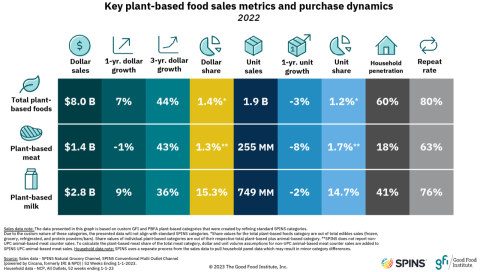Plant-Based Eating for Health
Helping shoppers with plant-based eating is a smart business strategy and opportunity for retailers to grow sales across the entire store. Plant-based food sales grew 6.6% over the previous year to reach $8 billion in total sales in 2022 in the United States, growing at a rate faster than animal-based food and total food and beverage sales. Health is a key factor driving shoppers to purchase plant-based food products, despite inflation and rising food costs.
According to the “2023 US Grocery Shopper Trends Report” from FMI — The Food Industry Association, 44% of consumers are making a greater effort to select more nutritious options versus a year ago. To help shoppers, retail-based Food as Medicine programs such as produce prescription initiatives empower shoppers to buy more plant foods, with the explicit goal of improving diet-related health conditions. The American Heart Association and the American Institute for Cancer Research both promote “plant-based” diets. When it comes down to speaking to consumers, however, there’s confusion about the foods that are included (and excluded) in plant-based eating. Following is what retailers need to know about healthier plant-based eating.
[Read more: "On Board With Plant-Based Charcuterie"]
Who Is the Plant-Based Shopper?
Everyone. Most individuals purchasing plant-based foods identify as “flexitarians,” meaning that they eat a wide range of foods, including animal foods, in addition to a wide range of other foods, including fruits, vegetables, whole grains, seafood, eggs and dairy. Shoppers who identify as vegetarians (may consume eggs and dairy) and vegans (no animal products) represent the minority of shoppers and less than 10% of the U.S. population.
According to “The Power of Plant-Based Foods,” a new report published in 2022 by FMI, younger generations, including Gen Z and Millennials, purchase more plant-based alternatives and make a greater effort compared with older generations, including Gen X and Boomers, in selecting plant-based foods and beverages.

Are All Plant-Based Products Better for You?
No. Highly processed or ultra-processed foods, whether they’re conventional or plant-based, may contain similar levels of artificial ingredients, preservatives, added sugar, sodium and fat that are associated with poor diet quality. Don’t be fooled by the plant-based “health halo” on processed deli meat, frozen pizza and entrées, and snack foods — most contain similar levels of calories, saturated fat and sodium when comparing nutrition facts on the label. To maximize the benefits of eating plants, choose whole-food forms: nuts, seeds, whole grains, and more fruits and vegetables.
How Can Retailers Retain and Attract More Plant-Based Shoppers?
“There’s an opportunity for retail grocers to capitalize both on the plant-based eating trend and the growth in consumer demand for prepared foods,” notes Marie Molde, MBA, RD, of food and beverage market research and intelligence platform Datassential. “By highlighting the convenience and value of plant-based prepared foods available in store for immediate or future consumption to their shoppers, supermarkets have an advantage over restaurants.”
For on-trend plant-forward menu inspiration focused on real plants:
Burgers: Try grilled mushroom burgers or blended-meat burgers.
Pizza: Plant-based vegetarian pizza with roasted vegetables, or Mediterranean pizza with artichokes, olives and sun-dried tomatoes, with the option of dairy or dairy-free cheese.
Taco Tuesday: Walnut “meat” tacos are on trend, while beans (plant-based protein) offer endless possibilities.
Vegetable Butchers: Create a destination and buzz with your customers.
Plant Protein Additions: Nuts, seeds, beans, tofu/soy, meat alternatives (beef, chicken, pork).
As credentialed health care professionals, registered dietitians (RDs) are uniquely qualified to help shoppers identify plant-based products that are suitable for specific health concerns. For example, the graphic on page 14 illustrates that plant-based milk is among the largest categories in sales and household penetration. Compared with dairy milk, however, most plant-based milks offer much less protein — a macronutrient that’s top of mind for many consumers today. Dietitians can advise shoppers with particular concerns about protein on the best plant milk alternatives.



.jpg?itok=D2RbKUbh)



